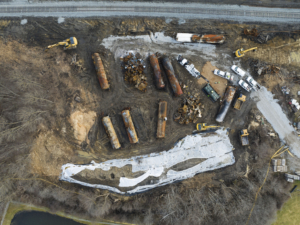Chemicals from Train Derailment Impact the Ohio River Watershed
By Heather Sprouse, Ohio River Coordinator, hsprouse@wvrivers.org
On February 3rd around 9pm, a Norfolk Southern train derailed in the village of East Palestine, OH – 1 mile west of the PA border, 20 miles north of West Virginia’s northern panhandle and 16 miles from the Ohio River. The train that derailed was carrying at least five different toxic chemicals. Following the accident, residents began to report rashes, headaches, coughs, digestive upset, dizziness and nausea. Fish, wildlife, livestock and pets died.
The timeline for this event is complex. Our friends at Ohio River Valley Institute (ORVI) created this graphic to help us understand what happened during the immediate aftermath.
One toxic chemical of concern is vinyl chloride. For fear of an uncontrolled explosion, on Monday February 6th, Norfolk Southern chose to “vent” this substance from 5 railcars by doing a controlled burn, a hasty maneuver without full approval from government agencies. This chemical burn forced citizens to flee for their lives, told by their governor that it was a matter of life and death.
While vinyl chloride is itself a carcinogen, the burning of the chemical releases hydrogen chlorine and phosgene, which can be immediately lethal. Phosgene, a highly toxic, colorless gas with a strong odor was notoriously used as a weapon during World War I.
Another chemical of concern is butyl acrylate that was released into nearby streams, 16 miles from the Ohio River. The Ohio River Valley Water Sanitation Commission (ORSANCO) is the agency tasked with monitoring the Ohio River for pollution to protect drinking water quality. The data released from ORSANCO reveals that butyl acrylate made it into the Ohio River. ORSANCO worked around the clock with local and state emergency response officials and environmental agencies to provide technical assistance and data to communities and government agencies, as it became available. However, ORSANCO is working with aging equipment and a limited budget.
On February 13, Ohio’s Department of Natural Resources confirmed that more than 40,000 aquatic creatures, including minnows and crayfish, died in waterways near the crash site. Despite the plethora of reported sicknesses from citizens and the death of wildlife, livestock and household pets, officials from ODNR, OEPA and EPA have consistently repeated that the municipal water is safe to drink. Well water is still being tested. Citizens, citing doubts around the transparency and thoroughness of this information, have sought independent tests and are awaiting results.
There are so many ways in which the railroad industry, including Norfolk Southern, knowingly put our communities at risk. Last year, Norfolk Southern actively blocked safety rules that could have prevented this disaster. They paid millions to executives while shedding safety concerns during staff cuts. They pressured the Obama Administration to exempt trains from carrying combustible chemicals being labeled as hazardous. They contributed millions of dollars to aid in the successful lobbying of the Trump Administration to roll back safety regulations, including mandates for the installation of modern brakes.
Additionally, Norfolk Southern did not immediately disclose all of the substances on their train– it wasn’t until February 10 that an EPA report revealed the full list. The five chemicals carried by this long train were released into the soil, the air and into our shared watershed. And it was clear by the rushed track repair just after the crash that the priority of Norfolk Southern was to get the railroad functional again as quickly as possible.





